This cashmere coat from Cifonelli, which I’ve had now for nine years, is similar in many ways to the two coats we’ve covered previously in this series – from Ciardi and from Liverano. There are some technical differences, however, which makes them interesting to compare and contrast.
Just as interesting, and perhaps more practical for many readers, is reflecting on how the coat has aged. Both the cashmere itself – which can be a delicate choice for an everyday coat – and the Cifonelli style with its extensive finishing, are things readers should bear in mind for any commission.
I’ll cover off the technical differences first, as I know there are readers that really like and appreciate that. Then move onto the practical points.
House: Cifonelli
Address: 31 Rue Marbeuf, Paris
Site: www.cifonelli.com
Cutter: Lorenzo Cifonelli
Price (at time of writing): €8500 (incl VAT)
Suit starting price: €7000 (incl VAT)
The biggest difference between this Cifonelli coat and the other two we’ve covered is the back – as we’re increasingly finding in this series.
The Cifonelli is by far the neatest, with a sharp box pleat in the centre of the back, one small pleat on either side, and a little more fullness gathered into the sewn-on belt. This is echoed below the belt, with three similar pleats running down to the hem.
The work is very fine, with ‘sprat’s head’ triangles sewn at the top of the two central pleats, and parallel rows of pick stitching sewn delicately around a lot of the edges, including the belt. There is no getting away from both the volume and precision of Cifonelli finishing.
The biggest style difference, however, is the fact the coat has no vent. Where the other two had a buttoned vent below the waist, to enable the wearer to move more freely, the Cifonelli has just a pleat. The entire bottom half of the back is made of just one piece of fabric – which must have been pretty big when laid out on the cutter’s board.
The upper back, too, is made of just one piece, despite the cut above the pleat that is then sewn into a seam. It’s this kind of hidden tailoring work that elevates Cifonelli as a piece of tailoring – as an object.
Having spoken to tailors about this coat, one other point that’s worth making is how natural the finishing feels. Although there is a lot of it – and that’s one reason I wouldn’t necessarily commission the same coat today – it all feels a natural part of the whole.
“It’s a hard thing to describe, but it feels like one person makes this style of coat all day long, day after day, and has done for years,” one English tailor commented. “It comes across in little things like the shape of the sprat’s heads, or where that pick stitching is placed and where it is not.”
I think this is something that bespoke customers often miss when they request elements of one tailor’s work be copied by another. There are so many little choices, such as the spacing of the pick stitching or the thread used, that a customer wouldn’t think to request and a tailor isn’t necessarily going to think of.
It comes back to a point we made with the Liverano coat, that much of this is best thought of as a language – a way of making something that has developed over time, that is distinctive, coherent and subtle, like intonation in language or choices between synonyms.
Two more examples of this with the Cifonelli. One, the pick stitching is close to the edges, where there is only a tiny amount of inlay. This makes the edges of the lapels, for example, much sharper than the Liverano, where more inlay and stitches set back from the edge create a real swelled edge.
And two, there isn’t much padding in a lot of the shoulder, but at the end there is a real lump that runs across into the top of the sleeve. This is what creates the distinctive Cifonelli shoulder – less the roping and more the way the construction creates a wide, thick sleevehead that’s a continuation of the shoulder padding.
Parisian tailors incorporate aspects from many other traditions, often from different parts of Italy. But these two examples demonstrate how they have adapted them and – over time – created their own language. Milanese shoulders have that thickness, but only in the shoulder, not the sleevehead, while Neapolitan edges have those two lines of stitching but not as fine or as sharp.
OK, so would I commission this coat again?
I don’t think I’d choose cashmere. The coat has aged well, there is no balding on the elbows or on the pocket edges. But the material is frustratingly soft and rarely holds a clean line. It has been recently pressed, yet the skirt is already a bit crushed and the beautifully made pleats are compromised. I’d choose a wool or wool mix, as with my Ettore coat.
I also wouldn’t do the same style. This is mostly how my tastes have changed, but there are also more objective things like not having postbox pockets on something smart like dark-navy cashmere. My changing tastes mean I might shy away from this amount of finishing, though it may be the combination of it with luxe cashmere. Perhaps in a wool the two would not seem too much.
I love wearing this coat, but I wear it a little more casually, and perhaps I’m lucky that that has been an effect of workplace requirements changing. With a sharp suit and tie, this coat could seem a bit flashy. With a knit and flannels as pictured, there is less going on and the coat can shine on its own.
Style breakdown
- Shoulder width: 6¾ inches
- Shoulder padding: Thin at the neck, thick at the sleevehead
- Sleevehead: Thick, wide but not tall
- Lapel width: 5½ inches
- Collar width (at gorge): 3 inches
- Gorge height: 4 inches
- Outbreast pocket height: 11½ inches
- Buttoning point: 20 inches
- Wrap: 3½ inches
- Back length: 44½ inches
Other clothes shown:
- Grey Dartmoor sweater
- Mid-grey flannel trousers from Whitcomb & Shaftesbury
- Black ‘Utah’ Piccadilly loafer from Edward Green
- Must de Cartier Tank watch with grey alligator strap, from Soobaak in Seoul


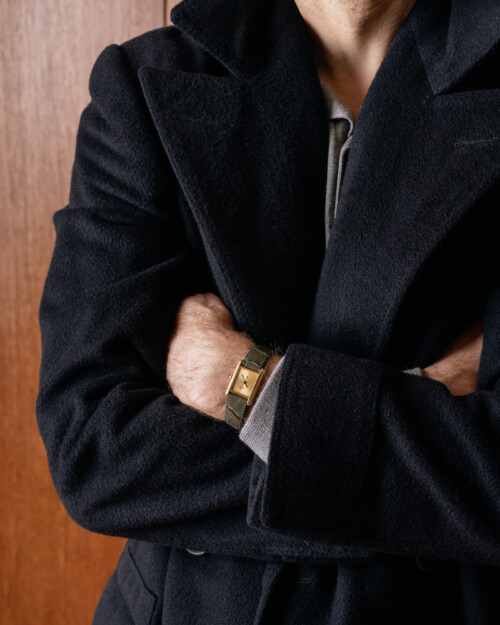
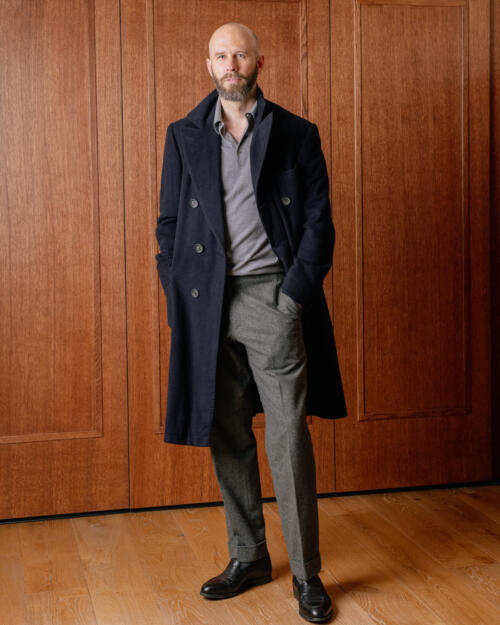
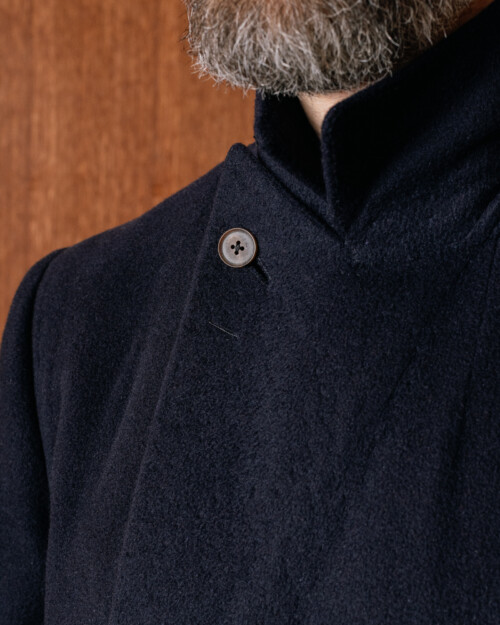
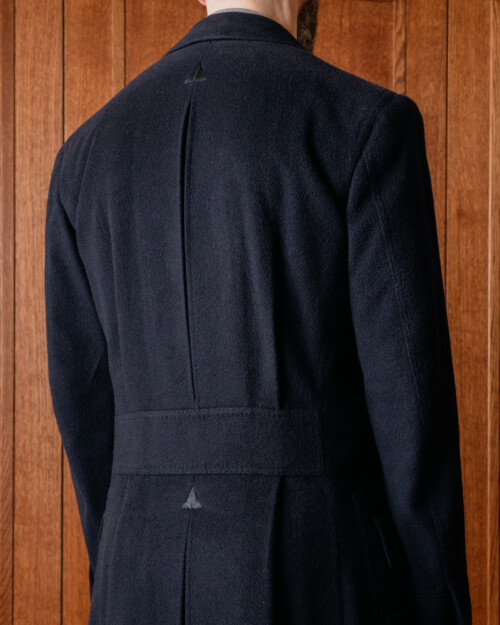
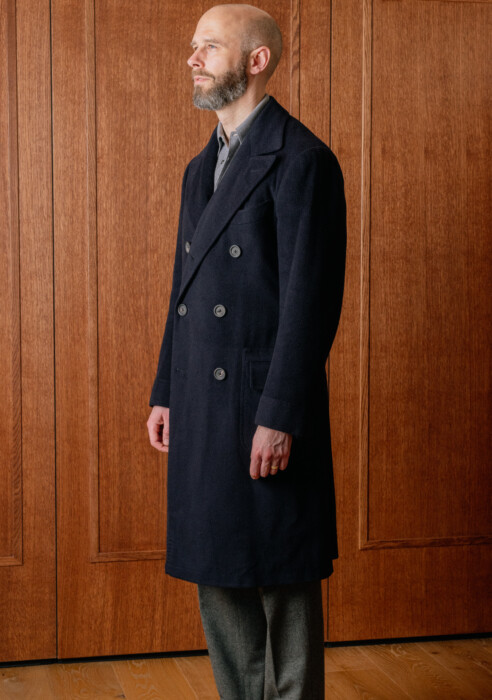
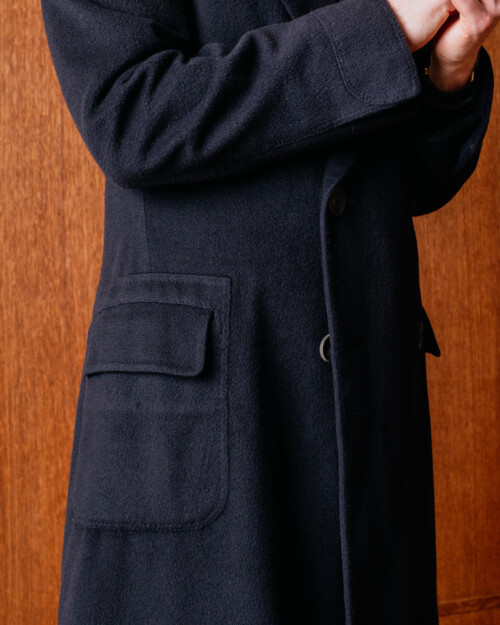
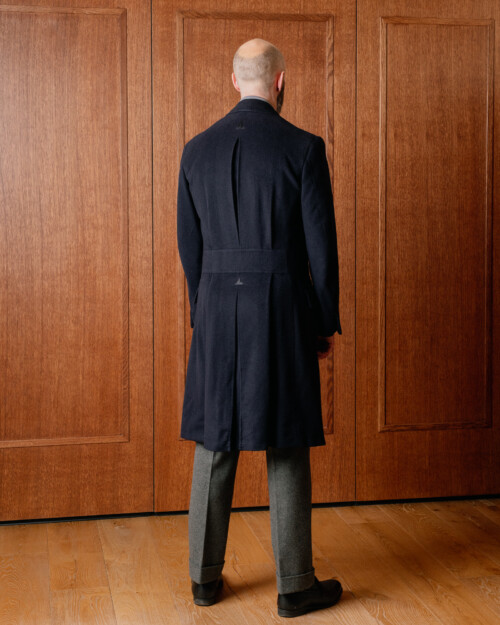
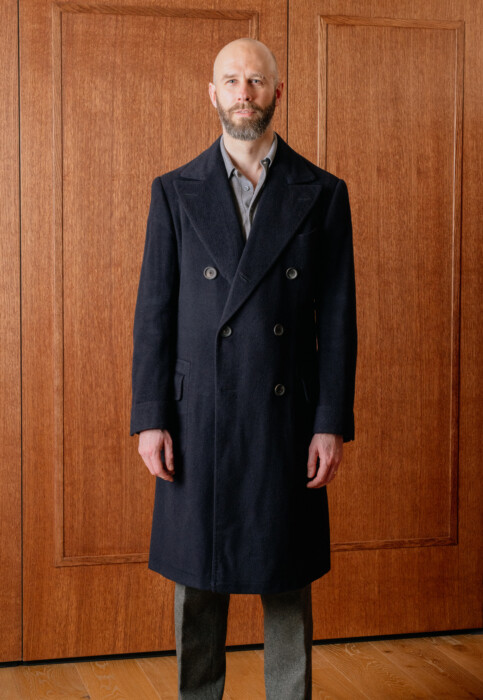
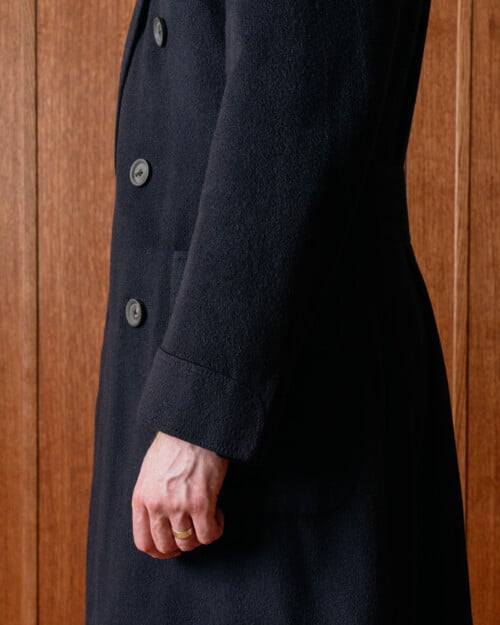
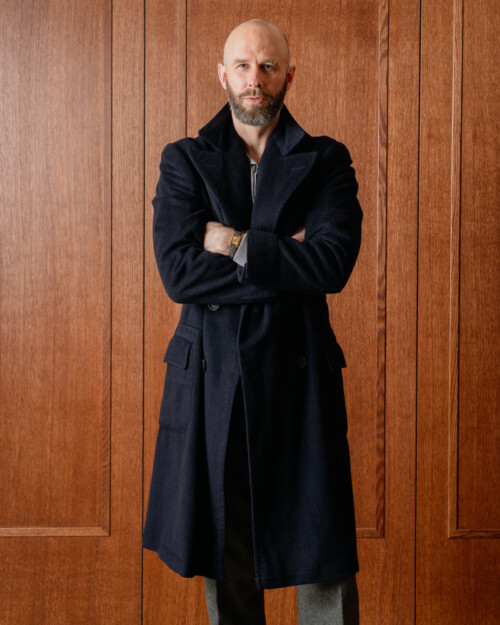


























This is an exquisite coat but the price today to have this coat made, over €8000 is a fearsome amount to pay .
I’d probably be looking to W&S if I were to commission a coat using the Classic India approach but I’m sure that the style would be different, albeit cheaper.
Hi Lindsay,
Yes the style would be different and so would the work. Not that that justifies the price, but it would be different.
While it is a lot of money, it’s “barely” over half of the price of the Liverano one 🙂
This is by far the one I like the most of all the coats I have seen on this site. If I could afford it I would consider it, but in an everyday material. As I would end up using it every day. I already do that with my long DB navy coat, I wear it with everything.
I see your point. For me it would be an ultra classical style of double breasted coat in very dark navy or midnight in a classic cloth mix like wool / cashmere / camel hair. Eg. an Ulster Coat.
Probably my socialization into menswear by Hugo Jacomet is to blame for this, but I’ve always thought of Cifonelli as the “luxury option” even within high-end bespoke, for both reasons of style and the finishing they do. Your coverage of them seems to indicate a similar perception. I can’t really think of another house I’m familiar with — which is admittedly not many — that achieves such an effect. Perhaps (if you will excuse the crude metaphor) Edward Sexton is the Lamborghini to the Cifonelli Ferrari…?
I would love one day to commission some formalwear from them. Unfortunately I’m a long way out from being able to afford such an extravagance.
I’m afraid I don’t know enough about cars to know how accurate the comparison is! But I’d say the major difference in finishing between French and English tailors is one of philosophy rather than quality – less of it but not necessarily any less finely done.
The style point is a separate one and Sexton is more of an outlier there
I remember when the original piece came out. Can´t really believe it´s been 9 years already reading religiously PS. Looking back it´s been a great journey from when i was only reading about these things as a uni student to being able to afford them. Thanks Simon, you´ve saved me many mistakes!
Glad to hear it Fernando, makes me feel better about the ones I make!
New watch, Simon?
Yes, picked up second hand in Korea (details at the bottom of the post)
Sorry to be a bore Simon but is the watch 23 by 30mm? Many thanks!
There’s another thread in these comments about it – it’s 20mm by 27mm
It’s a gorgeous piece, but I couldn’t help noticing the vintage Tank (which is, itself, gorgeous)!
Thanks Mark
New watch Simon ? Any plans to talk about it ?
Hey – yes details at the bottom. I can do sometime, yes
It’s a beautiful coat, but I can see how it’s a bit split in what it’s trying to be. What’s the weight of the fabric? Is the softness mostly about the material, or is the weight and weave also factors?
The fibre really, the raw material, rather than the weave or weight. It’s a nice dense cashmere and about 25oz if I recall
Hi Simon,
Would you ever go for a cashmere coat again, given that it doesn’t hold a clean line despite the dense weave? If so what style choices would you make to make it less on the sharp, formal side. I have tried a cashmere coat before and it feels wonderfully soft and fluffy. So I was contemplating commissioning one for a while.
I wouldn’t, personally, but it doesn’t mean you shouldn’t.
If I did, I’d have a simpler style – flap pockets, more of a straight vent in the back
Based on the things you’ve observed on this coat, could the characteristics of the material be used to make a more formal style of coat a bit more informal. A DB wool coat is always quite formal, but would the softness of cashmere make it a bit less formal? Or would it only look like a poorly pressed dress coat? (having trouble letting go of my dream of a cashmere coat!)
A different colour and texture of cashmere would help – say a brown with a prominent herringbone – and of course the style makes a huge difference too – see James’s cashmere raglan in the recent reader profile on him.
But all other things being equal, cashmere will usually make something smarter.
Be interesting what you think when you see the review of my B&Tailor coat in a week or so, as that’s a navy DB wool
I did, it re-ignited the cashmere coat dream. Sadly, it’s hard to justify another raglan when the PS donegal is so good!
Nice to hear
Hi Simon
I think the coat looks great, though if it were me I probably would have gone for a bit more casual cloth like your British warm for that style and a very simple, classic DB overcoat for that more elegant navy cashmere.
Regarding the fabric, is that vintage? If I am not mistaken 25 oz is around 850 grams. I can’t think of any mill that makes a 100% cashmere that heavy now, and at that weight it would probably cost the tailor at least 1000€ per meter making the final price fairly reasonable given the input costs and level of finishing.
Best regards
Andrew
Hey Andrew,
I double checked and my memory was almost right – it was 22oz from Harrison’s. Bear in mind also that this was nine years ago, so quality cashmere has gone up a lot since then.
Ah, I know that bunch. It’s a really nice one. I have a 50/50 cashmere wool overcoat made from the same bunch. I decided on a mix because it is slightly less shiny than pure cashmere
Sounds like a nice choice
It is definitely my favourite coat. I got it in 2018 and so far it has held up very well to quite frequent wear. I had the buttonholes redone last year as they were wearing out but apart from that the fabric hasn’t shown any signs of bagging at the elbows or wearing thin.
Wonderful
Also owning a DB cashmere coat, I agree with everything you said.
Also wear it more casually now that business trips are post-covid no longer as frequent (which is okay with me).
Works well with faded jeans, grey sweatshirt and dark grey beanie.
I’m going to get it in the neck here for bringing up price again but the point I’d like to make is that this really emphasises the bonkers price point of the Liverano coat…a full 7k more. When you take into account that Parisian rents are higher than Florence, Parisian salaries are higher, French taxes could arguably be more penalising, it makes this coat seem positively good value! Especially when you consider that Cifonelli is so renowned for the level of aesthetic and functional hand sewing that goes into their garments. Beautiful!
I like to think of Mr Liveranos price quote as a nice of way of saying, “I don’t want to make any more ulsters, but if you insist, its going to cost you”. After all he has at least 5 apprentices who can make you the same for less than half the price. The man is 86 years old after all! 86! I highly doubt he is now suddenly trying to cash in to buy a superyacht.
If anything they’ve lacked cash in recent years rather than had a surplus
Love that watch, what measurements does it have?
It’s tiny, 20cm by 27cm
thats big! 😉
Yes if it was mm it would have been modest but this is just insane 😉
Haha, yes mm not cm
I’d have to say Simon, this is my least favourite of the coats you’ve shown. The sheen on it simply isn’t my taste.
Thanks Matt, yes cashmere and the finishing aren’t for everyone
Matt raises a good point. Objectively, there doesn’t seem to be much in favor of cashmere compared to wool (including merino wool): Cashmere is much more expensive. It’s more delicate and less hardy. The environmental impact is much worse, in fact so bad that even some fashion companies started to out phase it. And – this is subjective – I think wool can have a better look than cashmere. Cashmere is softer, but good merino wool is not far off and much hardier. Cashmere is also slightly warmer, but for me that’s more of a disadvantage.Indeed, the cashmere trend of the recent years might slowly fade away.
How do measure the shoulder width? Sorry if it is obvious
It’s not obvious, but it is all set out in the introduction to this series
My main problem with this coat is that the combination of the roped, pagoda shoulders, soft material, and relative lack of waist suppression shrinks the wearer’s upper torso. The overall silhouette is a trapezoid rather than an hourglass. The dimple below the right shoulder seam—which wasn’t there in the original post of the coat—gives the impression that the shoulder is too big for the wearer. The comparison with the Ciardi ulster is notable, as the ulster gives a much stronger chest/shoulder silhouette while actually being narrower in the shoulders.
I agree that the drape of the cashmere is poor and especially detrimental around the shoulder/chest/waist lines. The whole coat is starting to look droopy though.
A finer critique: that buttonhole bisects the lapel in an unpleasant way—too high a cost for added practicality, which, let’s face it, will never actually be put into practice.
This has been a very useful series, in large part by providing comparison photos of these coats in the same lighting condition. To that end, it’d be helpful if the same perspectives are provided in every post. A full body profile shot of this and the Ciardi would be useful.
Thanks Ben.
I do find I use that button on the lapel a fair amount, but I agree there is a real aesthetic sacrifice there.
I wouldn’t analyse the fit on this and the Ciardi too closely as I’m wearing a jacket under that one, just a knit under this.
Why not keep the kits consistent if the point of the series is presumably to provide comparisons?
The point is not to use the pictures to make comparisons of fit, it’s something I always discourage anyway as it’s so hard to assess accurately on a screen. The pictures, as with review articles, are intended to give an overall impression of style and to be references for the points in the text
The coat’s fabric and tailoring is so fluid that it sits on you like a bathrobe, especially when you cross your arms. This is not such a bad thing, however I would not then wear a similarly fluid polo shirt beneath it as you’ve done here. The pants have enough formal structure to keep this outfit from floating away in the wind. Maybe something also more structured for the shirt would ground the outfit a tad more and compliment the unstructured, drapey, flow of the coat.
(The Ettore pea coat, by the way, is really sharp and seems to work better somehow. Just my two cents.)
Do you think maybe this free flowing cashmere fabric/ Cifonelli tailoring would work better as a sport coat or short pea coat? — So that the drapey nature offers just enough of something different without becoming a “liability”
Cashmere like this would certainly make a good sports coat, though you wouldn’t want it anywhere near as heavy
I thought the same thing. The fabric in the photos gave an almost toweling texture. I attribute that mostly to the photos though.
Hi Simon. If one were needing the warmest coat possible, would you still recommend cashmere, acknowledging the downsides you’ve outlined are the trade-offs to get that warmth? Or would you recommend an alternate fabric?
I wouldn’t go for cashmere necessarily, I’d get the warmth in a slightly heavier weight, in layering and in accessories.
Loden would be the way to go, short of obvious outerwear options. And there are some beautiful traditional loden coats out there, though I’m guessing it’s not your personal style, Simon.
I have used Loden cloth before. I’m not sure it’s that much warmer than wool, or warmer than cashmere?
I’m thinking of the traditional boiled wool variety. Maybe all loden is boiled wool, I’m not sure. But, yes, it may come down to the fine points of the heft of the fabric, etc.
Ah yes. I don’t think all Loden is, but I may be wrong
Loden is best for warmth in a traditional overcoat, short of outerwear options obviously.
Hi Simon, Excellent article and looking closely at the wonderful photos enlarged on my iPad I can see what you mean about the coat lines not being held. The pockets in particular stand out for me. However there are lovely style details in particular the back. You have convinced me that my goal of eventually getting a martingala cashmere coat is probably better in a wool cashmere blend. I have a Thom Sweeney mtm coat in that fabric that is 10 + years old and still in mint condition. I showed you my Sartoria Seminara wool coat which is probably 20 years old the last time you were in NY. Basically 9 years isn’t a long time to own a coat and based on your description and the photos I think I will drop my cashmere coat goal.
Thanks Thomas, and I remember that one. It looked excellent
The first full-length shot of you shows how casually elegant you can look. I think cashmere was a fine choice. The fabric is soft and sensual, yet sewn into a sharp, masculine shape. I love to pet cashmere when I see it in a beautiful garment. (I always ask first lol.) You wouldn’t get that effect in wool. I wouldn’t let this coat’s wrinkles bother you. Linen wrinkles but if it’s a beautiful fabric, no one cares.
I love the back. I’ve never seen details like that in any outerwear, men’s or women’s. I love how precise and linear they look. They’re intriguing but not flashy.
The postbox pockets make it more versatile for your more casual lifestyle.
This coat doesn’t seem a bit much to me. It seems just right.
Thanks, great having another viewpoint. It is hard to say without sounding odd how much you like stroking your own coat, or having others do so!
Lovely coat! Except for the postbox pockets, which seems incongruous to me with such a chique fabric and finishing.
Simon, I’ll pick up on the term “fearsome” from Lindsay and use it to make the point that my knees wobble when I think how many items I have seen on your page which, after receiving the most glowing praise initially, are now in the “would not again” category. Which of course, given the clear explanations you provide, makes these re-review pieces that much more valuable. At the same time, it puts the whole “investment” idea of highest quality clothing in some perspective and underscores how important it is to really wear and enjoy what you get yourself while you still can …
Yes I think that’s right Thomas. If we were having a broader discussion about it, I think there are a few other points I’d make about the correctness of choices like this, how things wear over time, and investment in clothing generally. For example:
– We all make mistakes with RTW purchases as well, and I personally have made more there than with MTM or bespoke
– I make considerably fewer mistakes as I get older, which is how it should be and is reassuring
– All the bespoke pieces that have had issues over the years (eg becoming too tight) have been easier to alter/correct than RTW would be. Because of things like hand-make and inlay, but also because of the relationship with the maker
I’m also less likely today to really stretch myself financially to buy something ‘perfect’ as I did when I was younger, but to buy less and to buy intelligently, so I can still spend good money on good clothes, without ever going crazy.
I don’t think that last sentence above really applies to much of what you commission or purchase for review on the site. My hallucination is that are laying out $100K per annum (at minimum) on clothing that often seems to be things you regift or resell or regret. The “to buy less” part is what I’m really wondering about: I see you buying “more and more” for the site (to review) than ever before (the frequency, the high dollar amount). And only time will tell: in 5 years, how many of the bespoke things you had done this year and last will also be things you’ll pass on because you never wore them? I don’t think it really matters – you are (other than high net worth individuals billionaires) – the exception to the rule: you can afford these clothes because of the site and the digital (and in person) world you’ve created as an authority on style. But it’s also interesting to think of the name of the site — Permanent Style — and how downright impermanent many of these choices were in your life. They may be “permanently stylish” choices (which is clearly up for debate) you’re making, but they are far from permanent in your life. Either way – you buy a LOT – commission a LOT – and pass onto others (wait for it) a LOT. And so I suppose you’re supporting craftsmen, artisans, resellers and friends/family (who are the end-re-users of your clothes and the beneficiaries of your largesse).
Thank you Wes. I’m certainly a complete outlier in that way and don’t buy in a way that I’d recommend to readers. Still, I wouldn’t say the things I commission are that often ones I regret – there are certainly some, but it’s always a small minority. And I give away quite a few things that I do like, just not quite as much as something else I have. There’s nothing wrong with them, they’re still relevant and stylish and belong on PS, it’s just that there’s a limit to what anyone can have and wear. So I wouldn’t say those two are necessarily the same.
The other lines are also still true. Even though I still commission a lot, and a lot of it is very expensive, I am tending towards not stretching myself financially (how much is obviously very relative) and I buy better than I used to, making fewer mistakes and idolising or overhyping certain makers a lot less. All of these things are useful things to talk about for other readers I think.
For the fashion conscious I suggest looking for a good vintage coat. There are a number of vintage resellers out there that sell great items, their descriptions are accurate and you can buy without worry. Cashmere coats are plentiful and relatively inexpensive. The grade of Cashmere is usually higher quality than contemporary offerings (except at the very high end like the ones in this article) but for those of us without that level of discretionary income buying vintage is a great avenue to pursue.
Hi Robert,
great input.Do you have any specific recommendations for trustworthy resellers if I may ask? (I hope this does not come across as advertisement, Simon).
I have thought about buying from a vintage reseller numerous times before, but have backed-up every time as I never know who to go for and what I can expect. Another fear is that the descriptions of the condition might be innacurate. Given the age of some of the items, you would wan’t some curration, so specific recommendations would be helpful here.
Not at all, pleased if you can help each other
The shaping in the chest seems less full in these pictures, but does that have to do with the fact there is not a jacket being worn underneath? It seems like the perfect coat to wear with a turtleneck sweater.
Slightly off topic, but do you still consider the 85% Golden Bale 15% Cashmere coating cloth offered by Harrisons (the very same cloth procured for your Sexton great coat) one of the best material for maintaining shape while still exhibiting softness?
I think that is the reason Dan, yes.
I think Golden Bale is great for that, yes, and we will cover the Sexton coat. I would say it is a smarter, smoother material than most wool coatings though
Simon,
I also recall when you first debuted this coat nine years ago. Time does fly!
It still remains one of my favorites in your collection. On your comment that it seems a little flashy when worn with a suit, is that really a bad thing? Isn’t a Cifonelli garment intrinsically flashy to some extent? Would you want someone to confuse your 8500 euro coat with something, say, from Suitsupply?
Well, no, but you could have something in a navy wool where the beauty was in the drape, for example, and the bespoke fit through the collar, or the turn of the lapels, rather than more flashy finishing. The comparison is to bespoke that is subtler, not to cheaper MTM
You model these clothes well in this article series – beautiful photos of the full outfits
.
Was wondering if the upcoming style book of yours has similar photography? (Just saw you confirmed its release for next month in another post)
Thanks Sigurd.
No the new book has street-style photography, like the first Style Guide
Simon, your collection of overcoats is absolutely superb and a tailoring treatise! Congratulations!
I have two questions.
From the three ulsters that you have reviewed so far, this is the oldest and the only one that buttons under the chin, right?
How useful have you found such feature over time? Would you do it again?
I was also wondering why none of your ulster coats has raglan sleeves, as opposed to the PS English Tweed Overcoat.
Would it be possible to make an ulster coat similar to the ones you have, but with raglan sleeves?
It’s just that I find the idea of a tailored double-breasted raglan overcoat so appealing!
Thank you for your fantastic work, it is a true privilege to have access to all the tailoring knowledge conveyed on PS.
Hey Luis,
Thank you. It is the only one, yes, but to be honest I don’t find it that useful. I wouldn’t do it again and haven’t done with most subsequent coats.
Raglan sleeves are more casual and I don’t think they really suit the tailored cut of these coats. The English Tweed is rather different, being no bespoke and much more unstructured. Personally I don’t think I’d make a tailored raglan DB.
Hope that’s helpful!
Hi Simon,
Thank you for your reply and for sharing your insights!
Perhaps I wasn’t very clear, but my idea of having a DB raglan overcoat bespoke is more related to the possibility of having a garment that fits me (which is often difficult to find) and of choosing a fabric that I like, than of having a very structured overcoat.
So from a more technical standpoint, which aspects of an overcoat construction do you find more adequate for a raglan DB? Perhaps no darts? A more simple back?
Thank you and keep up the great work!
Thanks Luis. That makes sense. I would still only go for it if you can see a design you really like, rather than trying to imagine it, and ideally from the tailor that will make it.
But in terms of what will make it more casual, I’d say it’s largely the structure and the cut, rather than those details. Less English, more Neapolitan
A beautiful coat. And / but not cheap.
i don’t think I could bring myself to pay that much for a coat even though, narrowly expressed, I can afford it. It’s not really rational, as I spend a lot on tailoring, but it’s a bit like I could not face myself in the mirror.
Simon, do bespoke tailors make bespoke trench coats too? It seems like they aren’t commonly offered by tailors. Not really liking ready-to-wear options for my partner.
They don’t tend to, because 90% of the tailoring work is not required – there is no structure, no need for 3D shape or really for hand sewing.
It’s better suited to a factory, which makes that style of garment all day long. Try and find one that does MTM
Hi Simon, the mid-grey polo and trousers look good although it’s quite an unexpected combination. To my eyes even though all your outfits are mostly corporate colours (grey, navy, and black), it doesn’t seem so at all. Why would this be the case? Also, would you wear the same combination with a navy jacket as well?
Many thanks,
Jack
Hey Jack,
Yes it’s basically a tonal look, grey and grey, which makes it more unusual and slightly more fashiony. We talked about it a bit here.
No I wouldnt’ do it with a navy jacket, I don’t think